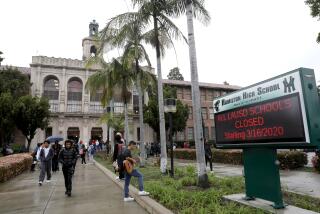Saddleback Schools Weighs 500% Hike in Developer Fees
Saddleback Valley school officials will consider a proposal today to halt further residential construction in the rapidly growing area until developers agree to fee increases of up to 500% to help build new schools.
“Basically we’re saying that we’re going to oppose any additional construction of homes that generate added students until provisions can be made to house them,” said Supt. Peter A. Hartman of a policy resolution being brought before Saddleback Valley Unified School District trustees.
Under that policy, the district would refuse to sign further fee agreements with developers for interim school facilities until an “adequate plan” is created for financing of permanent facilities.
Hartman, who last week sent a letter to nearly two dozen developers advising them of the district’s proposed action, said Sunday that the present $1,200-per-unit fee developers pay for temporary school facilities could climb to as much as $6,000 per unit for permanent ones.
The proposal brought a sharp response from the housing industry.
“The district is attempting to initiate a de facto building moratorium . . . that . . . could have severe financial consequences not only for developers and other businesses involved in the home-building industry, but also for financially strapped home builders who are also the direct recipients of increased costs,” John Erskine, executive director of the Building Industry Assn. in Orange County, said in a letter sent to Hartman and the county Board of Supervisors on Friday.
Erskine said his organization was “shocked by the district’s precipitous, unilateral action, not only because of its potentially disastrous effect, but also because of the complete lack of prior notification to and involvement of affected parties.”
He said the “district made not one attempt to notify us of the severity of its problem or elicit our involvement in an effort to solve the problem and forestall this kind of drastic action.”
The Building Industry Assn. said the district’s “position is untenable,” Erskine said, and that it “is not the appropriate governmental entity to legislate the criteria for financing permanent school facilities.”
Hartman, who said he had not received Erskine’s letter, denied that the district’s action was precipitous and said the BIA had to be aware of the overcrowding problems.
“There’s nothing new here,” Hartman said. “If they had attended any of our meetings for the last three years they would have heard about it.
“I happen to believe they are aware, unless they’re out of touch with their own membership. They know there is a lot of building going on in the Saddleback Valley and I don’t think we have to give them a lot of notice that they are building a lot of homes there,” he said.
Hartman said the problem is that developers “provide everything: drains, sewers, roads, fire stations. Everything for a community but schools.”
The county, which issues building permits and approves developments, “wouldn’t permit a developer to build roads of a permanent nature. But they can provide interim schools. That’s wrong.
Noting that the district has been collecting fees for interim facilities for five years, Hartman said, “One has to ask the question, ‘How long is interim?’ ”
“And the fact that we’ve been collecting for a number of years for interim facilities shows the impact their development is having,” he said.
Hartman said the vote by the board today is to be a signal to developers that the district “has to stop accepting these interim facilities.”
“We’re tired of talking to people who string you along. We’re tired of promises and hot air. It’s time to draw the line and say, ‘Enough is enough,’ ” he said.
Although the district has not settled on a figure for permanent facility fees, Hartman said, there has been consideration of adopting a plan similar to one used in northern San Diego County, where overcrowding problems have also been brought on by development.
Fees there, excluding land costs, range from $4,000 to $6,000 per unit, Hartman said, depending on whether it is an apartment, which might not add to school population, or a large family-style house.
Fees that high would be the largest by far of any assessed against development in Orange County.
Hartman also pointed out that one San Diego County district has already won a court fight over its right to collect fees for permanent facilities.
Times staff writer Kim Murphy contributed to this story.
More to Read
Sign up for Essential California
The most important California stories and recommendations in your inbox every morning.
You may occasionally receive promotional content from the Los Angeles Times.










